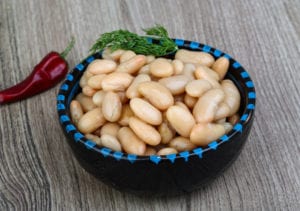Written by Jessica Patella, ND. Recent research compared a high-fiber bean diet to a low-carbohydrate diet and found both were effective for weight loss, but the high-fiber bean diet was better at improving cholesterol levels.
 An estimated 69% of U.S. adults are overweight or obese, with 36% being obese and 6% severely obese (2). These results are a public health concern, due to the increased cost of healthcare from side effects and loss of time at work. With the majority of the population overweight or obese, diets are popular, the question is which one is best? Recent research compared a high-fiber bean diet to a low-carbohydrate diet and found both were effective for weight loss, but the high-fiber bean diet was better at improving cholesterol levels (1).
An estimated 69% of U.S. adults are overweight or obese, with 36% being obese and 6% severely obese (2). These results are a public health concern, due to the increased cost of healthcare from side effects and loss of time at work. With the majority of the population overweight or obese, diets are popular, the question is which one is best? Recent research compared a high-fiber bean diet to a low-carbohydrate diet and found both were effective for weight loss, but the high-fiber bean diet was better at improving cholesterol levels (1).
The study included 173 participants, 18 years of age or older, with a Body Mass Index (BMI) between 30-44 kg/m2 (indicating obesity) (1). Participants were randomly assigned to either a high-fiber bean-rich diet (40+ grams of fiber per day for women; 50+ grams of fiber per day for men) or a low-carbohydrate diet (less than 120 grams of carbohydrate per day) (1).
Participants in the high-fiber bean-rich diet group began with eating one serving (1/2 cup) cooked beans with one meal each day and gradually increased to a serving of cooked beans with each of the three meals per day during the preparation phase. Kidney, black, garbanzo and pinto beans, as well as lentils were recommended (1 serving contains 7.9, 6.1, 4.3, 6.1 and 5.2 grams of fiber respectively) (1).
Participants in the low-carbohydrate group began reducing their intake of carbohydrates while increasing their consumption of protein-rich foods, such as fish, eggs and lean meats during the preparation phase (1).
At week 4 after baseline, each participant was given seven meals over 3 days (2 breakfasts, 3 lunches, 2 dinners). The meals were designed to educate participants on proper portion sizes and menu options for their respective diets. In general, the high-fiber group meals provided half a cup of beans or lentils with each meal and emphasized whole grains, vegetables and fruit. The low-carbohydrate meals consisted of a large meat, egg or vegetable protein, with 1-2 servings of non-starchy vegetables and a small fruit serving (1).
After 16 weeks, both groups decreased their weight, BMI, waist and hip circumferences and blood pressure. Only those in the high-fiber group showed improvement in total cholesterol and LDL or “bad” cholesterol levels (1). See chart for detailed results:
| High Fiber Week 0 | High Fiber Week 16 | Low-Carb Week 0 | Low-Carb Week 16 |
|
|---|---|---|---|---|
| Weight (kg) | 100.5 | 96.4 | 98.3 | 93.2 |
| Body mass index (kg m-2) | 36.5 | 35 | 36 | 34.1 |
| Waist (cm) | 111.6 | 106.1 | 112.3 | 105 |
| Hip (cm) | 119.5 | 114.7 | 117.5 | 112.8 |
| Systolic blood pressure (mmhg) | 131 | 126 | 137 | 133 |
| Diastolic blood pressure (mmhg) | 89 | 85 | 90 | 83 |
| Total cholesterol (mmol L-1) | 4.9 | 4.7* | 4.9 | 5.0* |
| LDL-cholesterol (mmol L-1) | 3.1 | 3.0** | 3.2 | 3.3** |
P-value for difference between groups: * p-value 0.038 **p-value 0.045
In conclusion, this study showed that a high-fiber diet and low-carbohydrate diet both resulted in weight loss for obese adults, although the high-fiber diet was more effective for lowering cholesterol levels (1). Larger studies should be considered in the future.
Source: Tonstad, S., N. Malik, and E. Haddad. “A high‐fibre bean‐rich diet versus a low‐carbohydrate diet for obesity.” Journal of human nutrition and dietetics 27, no. s2 (2014): 109-116.
© 2013 The Authors Journal of Human Nutrition and Dietetics © 2013 The British Dietetic Association Ltd.
Jessica Patella, ND, is a naturopathic physician specializing in nutrition and homeopathic medicine and offers a holistic approach to health. She earned her ND from Southwest College of Naturopathic Medicine in Tempe, AZ, and is a member of the North Carolina Association of Naturopathic Physicians. Visit her website at www.awarenesswellness.com.
References:
- Tonstad S, et al. A high-fibre bean-rich diet versus a low-carbohydrate diet for obesity. J Hum Nutr Diet. 2014, 27 (Suppl. 2), 109-116.
- Overweight and Obesity Statistics. National Institute of Health.
